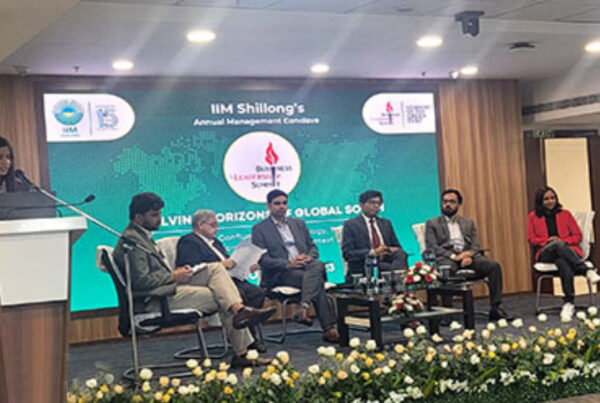The churn in the mining and metals industry is obvious.
Some of the leading mining companies worldwide, such as BHP, Anglo-Australian multinational miner Rio Tinto, South African miner Gold Fields, Chilean copper mining major Antofagasta, and Chinese mining group Zijin have each taken steps to boost the use of renewable energy in their mining operations. BHP, for instance, is developing solar and wind farms in Australia to run its coal operations, while Rio Tinto is working to reduce the annual carbon footprint of its copper mine in Kennecott Utah.
The metals and mining sector has long been considered a contributor to environmental degradation and a threat to sustainability. Mining operations are often associated with ill-effects such as extensive erosion, deforestation resulting in loss of biodiversity, sinkholes, socio-economic displacement of communities inhabiting the area around mines, and stagnant water bodies to name a few.
However, now the mining and metals industry is being seen as a critical cog in the wheel to address the climate problem and facilitate the transition to clean energy.
This is because the mining and metals industry is a provider of key raw materials needed for energy transition globally. According to the International Energy Agency (IEA), switching to clean energy technologies would significantly increase the requirement for critical minerals. For instance, lithium, manganese, nickel, and cobalt are needed in batteries, while rare earth elements are used in wind turbines and EVs. Electricity networks too require copper and aluminum.
Therefore, given that the demand for minerals is expected to increase for building a green infrastructure, energy transition presents a major opportunity for the mining and metals industry.
No wonder then that the metals and mining sector has catapulted to the core of the discussion on energy and the need to switch to clean energy technologies.
What are the factors driving the mining and metals industry?
Growing pressure from stakeholders: As challenges pertaining to biodiversity and water management intensify, the pressure on the mining and metals industry from different stakeholders – local communities, governments, regulators, end customers, employees, and investors – to sustainably manage operations and optimally utilize resources is growing. The focus, of course, differs from region to region. For example, in Chile, it is water management, while it is deforestation in Brazil. In the US, the focus is on the liabilities for mine closure and reclamation. As environmental and social issues take the center stage, concerns about the sourcing ecology of metals and minerals are proliferating.
Demand-pull: The growing preference for carbon-neutral lithium and nickel among battery manufacturers for use in clean energy technology, or for green steel and aluminum in the automotive sector is serving as a key factor in energy transition. Mining companies need to play by the changing rules if they intend to stay in the game.
A key aspect in this regard is the need for recycling. Considering the likely shortage of critical metals and minerals such as lithium or rare earths or copper, coupled with the growing push toward renewable sources of energy such as wind/solar power, recycling emerges as a veritable solution in energy transition. According to a study by Eurometaux, cited by the World Economic Forum, recycling offers significant potential –it is estimated that by 2050, recycling of energy metals could help Europe meet 40-75% of its clean energy metal requirements.
Recycling is also important from the perspective of self-sufficiency and reducing dependence on other regions. Europe, for instance, depends on Russia for the supply of metals such as aluminum, copper, and nickel.
This is pertinent in the light of the ongoing Russia-Ukraine war. While the full impact of the Russian invasion of Ukraine is yet to be realized or will unfold gradually, the ramifications for energy markets worldwide are serious. It could have a domino effect on several economies and poses a major question for energy security. Recycling, therefore, assumes importance as major countries try to find a solution to address their energy dependency, which could give a boost to their efforts to switch to greener sources of energy.
Financials: This is a major driver for the change in the perspective of the mining and metals industry. For miners, decarbonization presents a revenue opportunity, either by way of mining and selling the necessary raw materials for energy transition or by charging a premium for lower-carbon products. Also, decarbonization facilitates access to sustainability-linked funding associated with ESG, which helps in reducing the cost of capital.
Does this mean the road to transition is smooth?
Far from that. There are several challenges facing the mining and metals industry.
Challenges in mining industry
Value chain versus operational emissions: In the metals and mining sector, it is relatively easy to control emissions from operations, categorized as Scope 1 and 2 emissions. The challenge is in controlling Scope 3 emission, largely because it is associated with the value chain. The value chain includes upstream suppliers (that provide raw materials – copper, steel, and concrete – used in mine sites) as well as downstream customers that use base materials and metals in heavy-duty constructions such as buildings, bridges, ships, etc. A sophisticated solution is required to control these emissions.
Inadequate action to back claims: Many companies commit to carbon reduction only for the purpose of branding, or greenwashing as it is commonly known; this is one of the key challenges in the mining industry. Their efforts at installing or working with clean energy technology are a hogwash and they do not take steps in line with their projected commitment. Mining companies need to take concrete actions related to clean energy technology in order to adhere to the standards of industry associations.
A lot rides on the shoulders of mining companies when it comes to working toward energy transition. This is more so important considering the damage to environment and the pollution caused by mining operations. Given the focus on achieving net zero carbon emissions, it is imperative that mining companies take decisive steps in this direction. Therefore, under pressure from environmental activists and other stakeholders, many miners have setnet zero targets by 2050.
BHP, for instance, has set an emissions reduction target of 30%, while Rio Tinto eyes 15%, Vale 33%, Glencore 40%, and Anglo-American 30%.
More push toward sustainable mining: Environmental and social issues are among the key risks for miners. According to an EY report, cited in The Intelligent Miner, miners are increasingly working to integrate ESG into their strategies and decision-making. As pressure from stakeholders over biodiversity and water management increases, miners will need to plan judiciously for closure of mines and better manage their water and energy requirements.
Miners also need to work more for the socio-economic development of the regions where they operate, including the communities inhabiting these areas, so as to leave a positive legacy beyond the life of mine.
This includes properly measuring and recording data over the life of mine for effective decision-making, employing high-tech digital devices for the preservation of biodiversity, water, and waste management, using IoT for environmental monitoring, setting up efficient management and performance improvement platforms, having robust data management practices for ensuring compliance with legislations, etc.
Lack of interest/urgency: This is perhaps the biggest problem for the mining and metals industry.
Despite the talk around energy transition and clean energy technology, the different stakeholders such as governments or investors tread very warily when it comes to investing in mining. At the 121 Mining Conference in Cape Town, speakers pointed lack of interest as the biggest impediment to the use of clean energy technology in mining. This is visible across levels: major mining companies, for instance, are resistant to building new mines and adopting clean energy as it is expensive, while banks are not too keen to provide financing; plus, there is a general apathy among green investors toward mining, given its poor image. Investors are not very open to investing in new mines either because they are located in regions where rules and regulations are challenging and unfavorable, or development is increasingly getting costly, or because returns are realized only over the long term.
Stringent regulations: Unfavorable government policies present another major hurdle in the mining industry, even in countries that are developed and where mining is a key sector, such as Australia. Too many environmental or other local community-related approvals are required, which acts as a deterrent.
For the efforts of the mining sector to be effective in terms of transitioning to clean energy, as the spotlight falls on responsible production and mining, the government has a key role to play. Laws need to be stringent with clearly defined contractual and legal framework and structure. The Climate-Smart Mining Initiative, launched by the World Bank and IFC, for instance, is an effort aimed in this direction. Its objective is to facilitate sustainable mining and processing in resource-rich developing countries and recycling of minerals for low-carbon technologies and other critical sectors, besides minimizing the climate and material footprints along the value chain.
Another key step in this regard is the adoption of the polluter pays principle by many governments, and the shift from the conventional prescriptive approach (which technologies should be adopted) to performance-based regulation, such as environmental impact assessment. This will help both mining companies and the government to come up with more effective policies.
With regard to implementation of policies, governments need to implement more laws for community consultation throughout the life of mine. The Dodd–Frank Wall Street Reform and Consumer Protection Act (Dodd-Frank) in the US and the Organisation for Economic Co-operation and Development (OECD) Due Diligence frameworks in the EU are a case in point. However, not just more such regulations need to be implemented but the pace should pick up in developing countries as well, where these issues are often clubbed under national laws that often tends to become ineffective, given the umbrella-like approach of the regulation.
Insufficient planning: According to the IEA, planning for mineral supply and investment does not adequately envision the requirement for transforming the energy sector. This has raised the risk of delays or increase in the cost of energy transition. There are several risks to reliable, affordable, and sustainable supply of clean energy technology minerals such as cobalt, lithium, and copper. These include high geographic concentration that could render supplies vulnerable in the case of a conflict (for instance, Congo and China accounted for nearly 70% and 60% of the total production of cobalt and rare earth elements worldwide, respectively, in 2019); long project development lead times (considering that it takes almost 16 years on average for mining projects to progress from the discovery phase to the first production stage, if demand were to pick up rapidly, supply would not be enough to ramp up output); declining quality of resource(extraction of metal from lower-grade ores consumes more energy, besides increasing production costs, greenhouse gases, and waste); and vulnerability to climate risks (mining assets are exposed to the risk of climate change; copper and lithium are particularly exposed to water stress as their extraction requires huge quantities of water, posing a threat to sustainable supply).
Russia-Ukraine conflict: The war has not just disrupted the supply of metals and minerals used in EVs but also affected the supply/prices of oil used in ICE vehicles. This indicates how these key inputs are vulnerable to crises and/or geopolitical tensions. This has naturally derailed the efforts for transition to clean energy.
Crises such as these create what are typically known as “greenwalls”, or deterrents to energy transition. This dissuades nations that are actively pursuing net-zero strategies to continue their efforts for scalability and adaptability. These countries are forced to contend with the price hikes, or green upcharges, which impacts both renewable sources and clean technologies that use metals and minerals.
This has also reduced the lure of the green premium, or the hike customers/nations are willing to accommodate in the switch to clean energy. No wonder nations that signed the Paris Agreement are sidestepping it and opting for fossil fuels again, including the US and UK.
What is the way forward for the metals and mining sector in energy transition?
Given the criticality of the issue and the challenges in mining industry, concerted action by all the stakeholders, primarily mining companies, is required. Several studies and researches have been conducted or are underway currently to help in the development of a feasible plan of action.
A study by Accenture outlines several approaches mining companies can take to increase efficiency and decrease carbon output over the short term and long term. These are: using AI and ML to improve efficiency, automating operations to reduce energy consumption, adopting blockchain to measure and audit emissions, implementing carbon price to aid in daily decision-making, switching to biofuels and using less power-intensive equipment over the short term; and replacing onsite fossil-based fuel power generation with renewable sources of electricity, adopting hydrogen fuel cell technology for running machinery and haulage; and re-fleeting with electric vehicles over the long term.
The IEA, on the other hand, proposes recommendations to secure the supply of minerals, as the other side of the coin. The underlying principle is effective participation of a key stakeholder – the government or policymakers that can contribute significantly by way of favorable policies to attract investment and incentivize performance, and their collaboration with companies. These include ensuring adequate investment in diversified sources of new supply; promoting innovation in technology at all points of the value chain; scaling up recycling; enhancing supply chain resilience and market transparency; promoting higher environmental, social, and governance standards; and strengthening international collaboration between producers and consumers.
To conclude
We are at a turning point in climate change. Given the role of the mining and metals industry in the economy and the impact of these operations on the environment, the metals and mining sector is no doubt in the spotlight in the discussion on energy transition. However, the pace of energy transition is slow – very slow – given the challenges in mining industry and also because the approach so far has not been very well-defined.
There is no denying that we need to be carbon neutral, the global economy as a whole, developing nations, and developed nations alike. However, the moot point is – is this possible? From the discussion above, it is clear that the road to this is not easy, especially with geopolitical issues often complicating the matter. Plus, the economic situation of an individual country, its social and political compulsions included, may pose a major challenge.
And while companies in the metals and mining sector have been taking steps toward energy transition, a lot of ground needs to be covered. The drivers of the change are complex, particularly due to the varying interests of the different stakeholders in energy transition. Certain aspects of energy transition itself are debated today – some researchers question the impact of low-carbon technologies in terms of straining existing resources. Many such challenges in mining industry need to be answered.
This is where the government needs to step in, especially when there is reluctance on the part of clients or customers to pay a green premium. With affordability and security posing a bigger concern in the face of climate-based requirement, the need of the hour is to collaborate effectively and envisage actions collectively as well as individually. As governments and companies collaborate, they will be able to better address the existing pattern of energy consumption and come up with clean energy technologies for energy transition.
Above all, now is the time to replace rhetoric with action.
For further insights on Metals and Mining, connect with Ankur Rastogi, Vice President, Business Research at Avalon Global Research.




